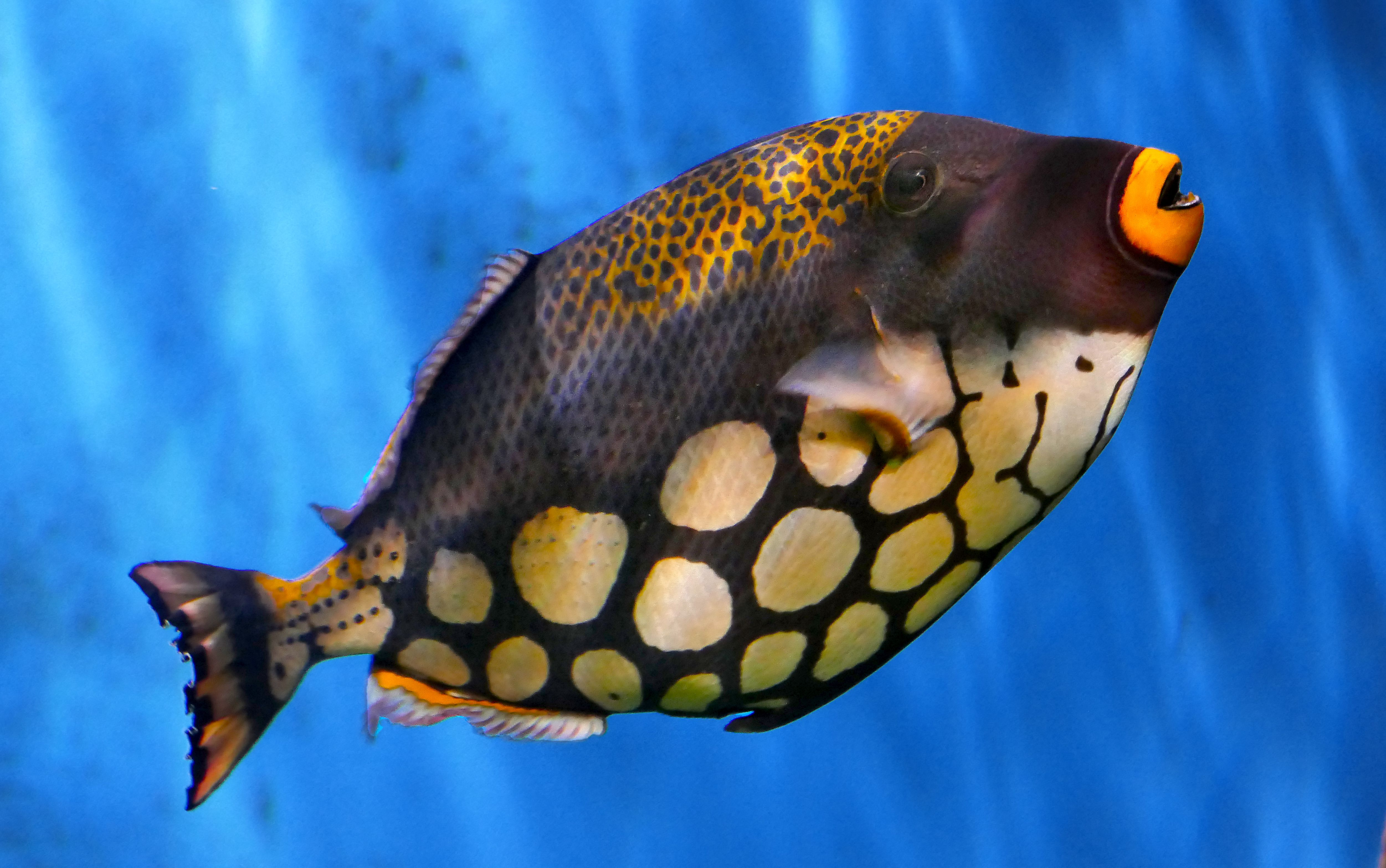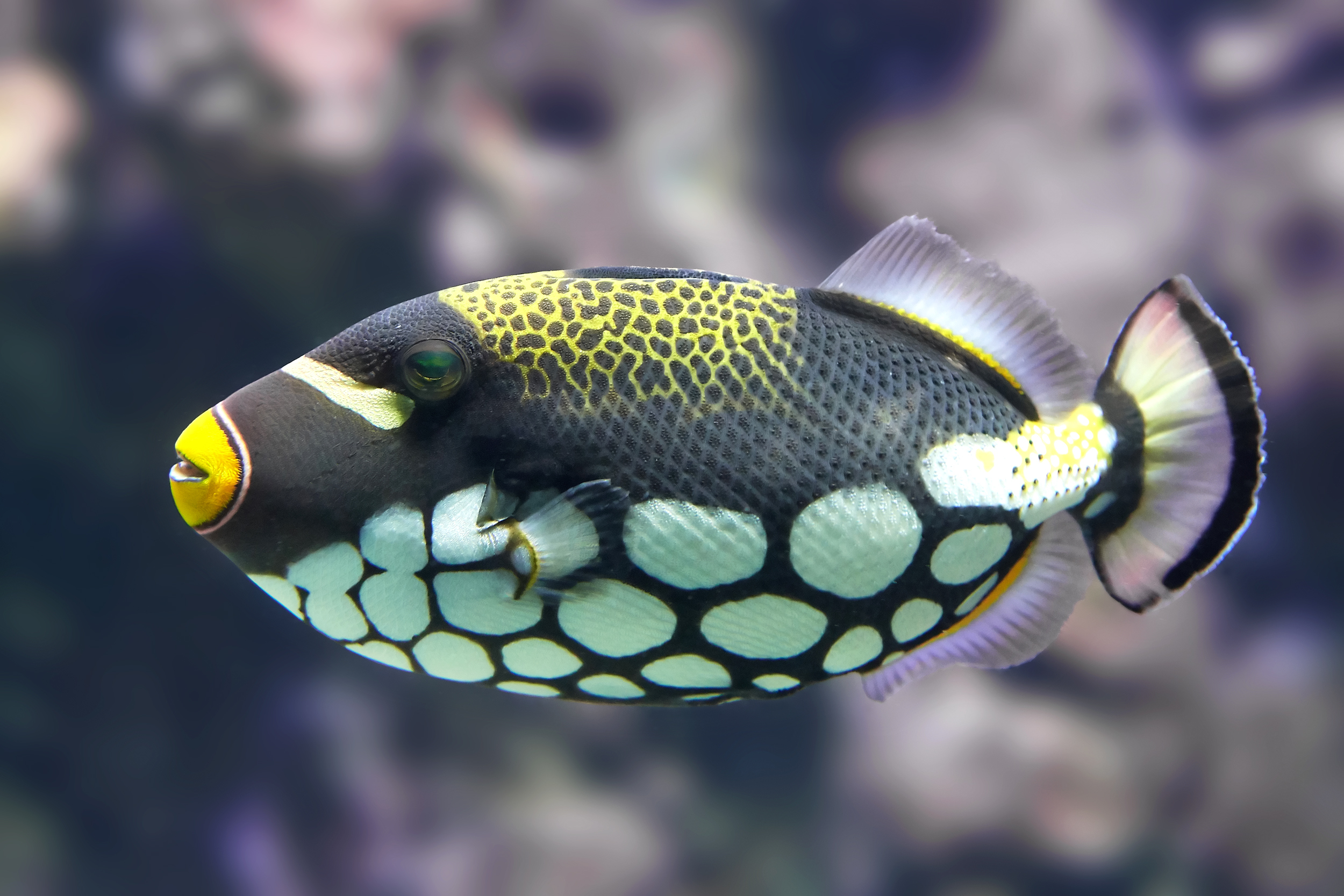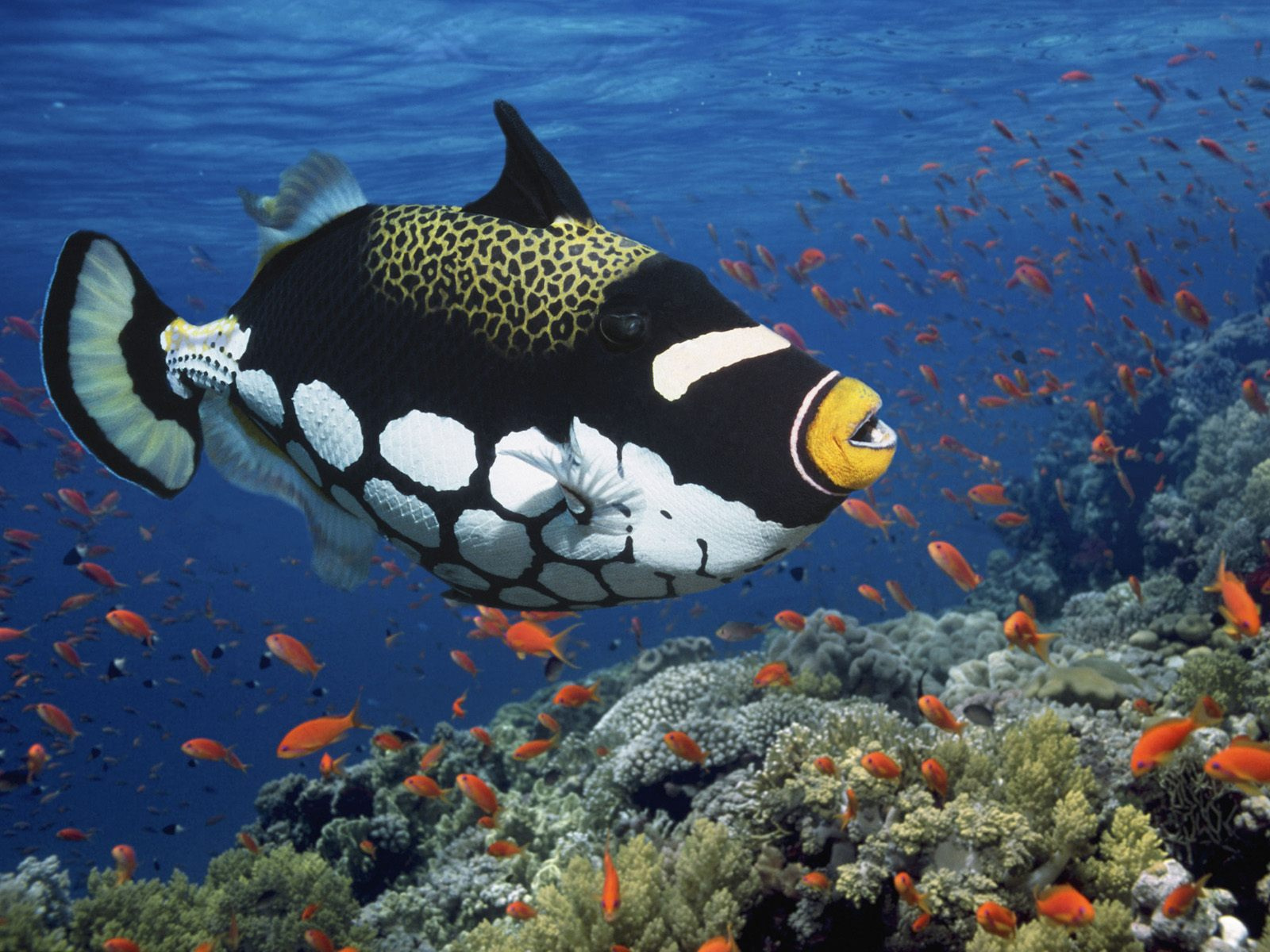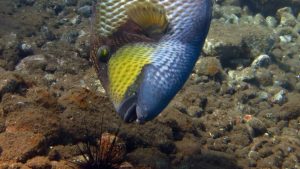Welcome, intrepid readers, to the world of triggerfish! These fascinating creatures have long captivated researchers and divers alike with their unique characteristics and enigmatic behavior.
In this article, we’ll dive deep into the world of triggerfish, exploring their habitat, behavior, diet, and their important role in the ecosystem. So put on your snorkel and let’s unravel the mystery of the triggerfish!
Introduction to the Enigmatic Triggerfish

When you think of fish, the triggerfish may not be the first species that comes to mind. But these fascinating creatures are anything but ordinary. So, what exactly is a triggerfish? Let’s find out.
What is a Triggerfish?
Triggerfish are a family of tropical and subtropical marine fish that belong to the order Tetraodontiformes. They are known for their distinctive shape, with a stocky body, small mouth, and sharp teeth. But what truly sets them apart are their unique, movable spines, known as “triggers,” which they use for defense against predators.
The Unique Characteristics of Triggerfish

When it comes to marine diversity, triggerfish (Rhinecanthus aculeatus) are a fascinating group that captures the attention of scuba divers and researchers alike. As part of the Balistidae family, these brightly colored fishes display a range of distinctive color patterns and boast a set of strong teeth in their small mouths. Their most remarkable feature is the large dorsal spine, which they use to establish territories and ward off predators.
With numerous triggerfish species swimming in the oceans, each showcases its own flair. The striking Clown Triggerfish is a popular choice in the aquarium trade, thanks to its vibrant appearance and engaging behavior. In contrast, the Gray Triggerfish and Grey Triggerfish are known for their presence in subtropical waters.
One peculiar example is the Titan Triggerfish (Balistoides conspicillum), the largest species in the family. Its imposing size and territorial tendencies make it a serious threat to other marine creatures.
Triggerfish are not only aesthetically intriguing but also exhibit captivating behavior. During the breeding season, they construct hollow nests in sandy bottoms, serving as traditional spawning sites where eggs hatch and fry develop. This behavior allows them to maintain healthy populations and plays a vital role in marine ecosystems.
Lastly, triggerfish are known for their territorial behavior. They establish and defend their territories with great determination. When an intruder enters their space, triggerfish will display aggressive behavior, flaring their fins and charging at the intruder. This territoriality is not only a means of protecting their resources but also a way to establish social hierarchies within triggerfish communities.
The Habitat and Distribution of Triggerfish

Triggerfish can be found in various parts of the world’s oceans, but their distribution is mainly concentrated in tropical and subtropical regions. Let’s take a closer look at where they call home.
Where Do Triggerfish Live?
Triggerfish are commonly found in coral reefs, rocky coastlines, and seagrass beds. These habitats provide them with ample opportunities to find shelter, search for prey, and reproduce. Coral reefs, in particular, are rich in biodiversity and offer a diverse range of food sources for triggerfish.
The rocky coastlines provide crevices and caves where triggerfish can hide from predators and lay their eggs. Seagrass beds serve as nurseries for triggerfish juveniles, providing them with protection and abundant food.
In addition to these habitats, some species of triggerfish have also been known to inhabit deep waters, venturing down to depths of more than 100 meters. These deeper waters offer a different set of challenges and opportunities for triggerfish. They may encounter different prey species and have to adapt to the colder temperatures and higher pressures of the deep-sea environment.
The Migration Patterns of Triggerfish

While triggerfish are not known to undertake long-distance migrations, they do exhibit seasonal movements within their habitats. These movements are often driven by factors such as food availability, temperature changes, and reproductive behaviors.
During the warmer months, triggerfish may migrate to shallower waters where food sources are more abundant. As the water temperature increases, the metabolism of triggerfish speeds up, and they require more food to sustain their energy levels. By moving to shallower waters, they can take advantage of the increased productivity and find an abundance of prey.
During the breeding season, triggerfish may also undertake short-distance migrations to find suitable spawning sites. Male triggerfish often establish territories and build nests on the seafloor, where females will lay their eggs. The migration to these spawning sites ensures that triggerfish have access to the appropriate conditions for successful reproduction.
Overall, the habitat and distribution of triggerfish are influenced by a combination of factors, including food availability, temperature, and reproductive needs. Their ability to adapt to different environments and undertake seasonal movements allows them to thrive in various parts of the world’s oceans.
The Behavior and Lifestyle of Triggerfish

Triggerfish have a complex social structure and fascinating mating habits. Let’s take a closer look at their behavior and lifestyle.
The Social Structure of Triggerfish
Triggerfish are generally solitary creatures that establish and defend territories. Within their territories, they maintain hierarchical social structures. The dominant male triggerfish guards his territory, attracting multiple females to mate with. Other males may also live in the vicinity, but they are subordinate and only allowed to mate if the dominant male is absent or weak.
In addition to defending their territories, triggerfish are known for their unique nesting behavior. They create nests by clearing away debris and using their strong jaws to bite and break coral or rocks. These nests provide shelter and protection for the eggs and young triggerfish.
Within the triggerfish social structure, there is also a clear division of labor. While the dominant male takes on the role of defending the territory and attracting females, the females are responsible for building and tending to the nests. They carefully arrange and maintain the nest, ensuring it remains in good condition for the eggs to develop.
Interestingly, triggerfish are also known to engage in cooperative behaviors within their social groups. For example, subordinate males may assist the dominant male in defending the territory or caring for the eggs. This cooperation helps to maintain the stability and success of the triggerfish community.
The Mating Habits of Triggerfish

Triggerfish engage in an elaborate courtship ritual before mating. During this ritual, the male triggerfish changes colors and performs intricate displays to attract a female. The vibrant colors and patterns on their bodies serve as visual cues, indicating their readiness to mate and their overall health and fitness.
Once a female is enticed, the pair performs a synchronized dance, releasing eggs and sperm into the water simultaneously. This simultaneous release increases the chances of successful fertilization, as it ensures that the eggs and sperm are in close proximity to each other.
After the eggs are fertilized, they are left to drift in the open water until they hatch. This is known as pelagic spawning, a reproductive strategy employed by many marine species. The triggerfish eggs are small and transparent, making them difficult to spot, which provides some protection against predation. The eggs hatch into larvae, which then undergo a period of development before transforming into juvenile triggerfish.
It is worth noting that triggerfish are highly protective of their eggs and will aggressively defend their nests against any potential threats. They use their sharp teeth and strong jaws to ward off predators and intruders, displaying their commitment to ensuring the survival of their offspring.
The Diet and Predators of Triggerfish

Triggerfish have a diverse diet and face their fair share of predators. Let’s explore what keeps them nourished and the threats they encounter.
What Do Triggerfish Eat?
Triggerfish are omnivorous, meaning they eat both plant and animal matter. Their diet includes a variety of items, such as crabs, shrimp, small fish, sea urchins, coral, and algae. Their powerful jaws and beak-like teeth allow them to crush the hard shells of their prey with ease.
When it comes to plant matter, triggerfish are particularly fond of algae. They use their sharp teeth to scrape algae off rocks and coral, playing a crucial role in maintaining the balance of these ecosystems. By consuming excess algae, triggerfish prevent it from overgrowing and smothering other marine organisms.
In addition to their primary diet, triggerfish also have a taste for invertebrates such as mollusks and crustaceans. They are skilled hunters, using their keen eyesight to locate their prey and their strong jaws to capture and consume it.
Natural Predators of the Triggerfish

Despite their formidable defenses, triggerfish are not without their share of predators in the underwater world. Larger fish, such as groupers and barracudas, feed on triggerfish. These predators are attracted to the triggerfish’s vibrant colors and unique body shape, making them an enticing meal.
Additionally, some shark species, like the lemon shark, have been known to prey on triggerfish. Sharks are opportunistic hunters and will take advantage of any available food source. Triggerfish, with their slow swimming speed, can become an easy target for these apex predators.
However, triggerfish can use their triggers to their advantage, wedging themselves into crevices and making it difficult for predators to extract them. These triggers are the modified spines on their dorsal fins, which can be locked into an upright position to prevent predators from swallowing them whole.
Another fascinating adaptation of triggerfish is their ability to change color and pattern to blend in with their surroundings. This camouflage technique helps them avoid detection by predators and increases their chances of survival.
Furthermore, triggerfish are known to be highly territorial and will fiercely defend their nests and offspring. They construct nests in sandy areas on the ocean floor and guard them against potential threats, including predators that may try to prey on their eggs or young.
The Role of Triggerfish in the Ecosystem

Triggerfish play a crucial role in the delicate balance of the underwater ecosystem. Let’s explore their importance in coral reefs and their impact on other species.
The Importance of Triggerfish in Coral Reefs
Triggerfish are considered keystone species in coral reef ecosystems. They help control the populations of certain organisms, such as sea urchins, which can overgraze on coral reefs. By feeding on these herbivores, triggerfish prevent the excessive destruction of coral, allowing the reef to thrive.
The Impact of Triggerfish on Other Species
While triggerfish benefit coral reefs, they can also have an impact on other species. For example, triggerfish are known to create and defend small nesting cavities on the seafloor. These cavities attract various species, providing them with shelter and protection. However, triggerfish aggressiveness towards intruders can limit the availability of these nesting sites for other fish.
And there you have it, dear readers! A glimpse into the captivating world of triggerfish. From their unique characteristics and behavior to their vital role in the ecosystem, these enigmatic creatures continue to intrigue and amaze. So, the next time you find yourself near a coral reef, keep an eye out for the triggers and uncover the mysteries of the triggerfish!
Clown Triggerfish

Among the most captivating species in the Balistidae family, the Clown Triggerfish (Rhinecanthus aculeatus) mesmerizes with its distinctive color pattern. Found in subtropical waters, it stands out among other fish, making it a favorite among scuba divers and aquarium enthusiasts.
This species boasts strong teeth and a tough jaw, allowing it to feed on benthic invertebrates, sea urchins, and even larger fish, posing a serious threat to reef invertebrates and smaller fish.
Difference between Triggerfish Species, Sea Urchins, and Other Fish

When exploring the vibrant underwater world, one cannot help but marvel at the diverse marine life that inhabits our oceans. Among the many fascinating creatures, the Triggerfish stands out with its unique characteristics.
The Clown Triggerfish (Rhinecanthus aculeatus) is a striking member of the Triggerfish species, known for its distinctive color pattern and popularity among scuba divers and enthusiasts in the aquarium trade.
Triggerfish encompass a wide variety of species, each with its own features and habits. From the majestic Queen Triggerfish to the elusive Crosshatch Triggerfish, their habitats vary from reef invertebrates to the open ocean. Triggerfish are well-adapted predators, sporting strong teeth and large dorsal spines that deter predators and help them establish territories.
On the other hand, sea urchins and other fish exhibit their own fascinating traits. Sea urchins, like the Ocean Triggerfish, are benthic invertebrates often found in sandy bottoms. Other fish, such as the Gray Triggerfish, have small mouths and use their upper jaws to feed on smaller prey.
One noteworthy example is the Titan Triggerfish (Balistoides conspicillum), the largest species in the family. Its imposing presence and territorial behavior make it a serious threat to other marine fishes.
In conclusion, while triggerfish species showcase a remarkable diversity in terms of size, color, and habitat, sea urchins and other fish exhibit distinct adaptations to their environments. Exploring the intricacies of these underwater marvels reveals the awe-inspiring wonders that our oceans hold.

